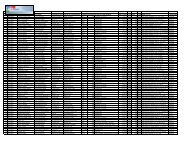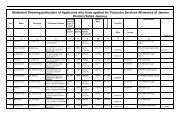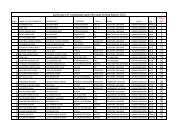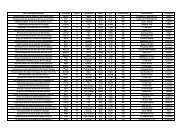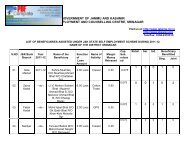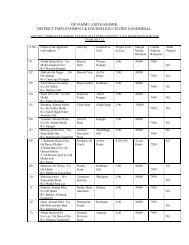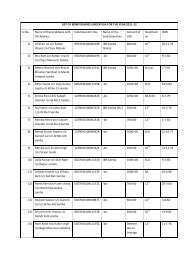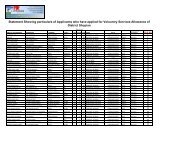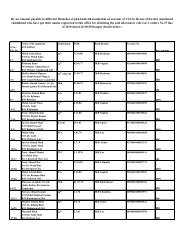Schemes->Swaran Jayanti Shahri Rozgar Yojna - Department of ...
Schemes->Swaran Jayanti Shahri Rozgar Yojna - Department of ...
Schemes->Swaran Jayanti Shahri Rozgar Yojna - Department of ...
Create successful ePaper yourself
Turn your PDF publications into a flip-book with our unique Google optimized e-Paper software.
<strong>Schemes</strong>-><strong>Swaran</strong> <strong>Jayanti</strong> <strong>Shahri</strong> <strong>Rozgar</strong> <strong>Yojna</strong>Name <strong>of</strong> the Scheme :Implementing AgencyOfficial(s) to beContacted.<strong>Swaran</strong> <strong>Jayanti</strong> <strong>Shahri</strong> <strong>Rozgar</strong> YojanaHousing & Urban Dev. <strong>Department</strong>, J&KChief Executive OfficerJammu Urban Dev. Agency (JUDA)Srinagar Urban Dev. Agency(SUDA)THE SWARNA JAYANTI SHAHARI ROZGAR YOJANAINTORUDUCTION:The swarna <strong>Jayanti</strong> Shahari <strong>Rozgar</strong> Yojana(SJSRY) shall seek to provide gainful employment to the urban unemployed orunderemployed poor through encouraging the setting up <strong>of</strong> self-employment ventures or provision <strong>of</strong> wage employment. Th is programme willrely on creation <strong>of</strong> suitable community structures on the UBSP pattern and delivery <strong>of</strong> inputs under this prgramme shall be through the medium<strong>of</strong> urban local bodies and such community structures.The Swarna <strong>Jayanti</strong> Shaharl <strong>Rozgar</strong> Yojana shall be funded on a 75:25 basis between the Centre and the States.(i)(ii)The Swarna <strong>Jayanti</strong> Shahari <strong>Rozgar</strong> Yojana shall consist <strong>of</strong> two specilal schemes, namely:-The Urban Self Employment Programme( USEP)The urban Wage Employment Programme(UWEP)SALIENT FEATURES:The Swarna <strong>Jayanti</strong> Shahari <strong>Rozgar</strong> shall rest on a foundation <strong>of</strong> community empowerment. Rather than relying on the traditionalmethod <strong>of</strong> top down implementation, this programme shall reply on establishing and promoting community organisations and structures toprovide supporting and facilitating mechanism for local development. Towards this end community organisations like Neighborhood Groups(NHGs). Neighbourhood Committees (NHCs), and Community Development Societies(CDSs) shall be set up in the target areas based on the UBSPPattern(Annexu re IV). The CDSs shall be the focal point for purposes <strong>of</strong> providing whatever other support is necessary to the programme. TheCDSs will also identify viable projects suitable for that particular area.These CDSs may also set themselves up as Thrift and Credit societies to encourage community savings, as also other group activities. However,Thrift and Credit societies may be set up separate from the CDSs as well. These bodies will try to link local resource generation efforts withwider institutional finance. It is expected that these bodies will be registered under the Societies Registration Act or other appropriate Acts toprovide them direct access to funds under various schemes as also a wider finance and credit base. A maximum expenditure at the rate <strong>of</strong>Rs.100 per member for the first year, and Rs.75 per member for each subsequent year will be allowed for activities connected with the CDSs.The CDS, being a federation <strong>of</strong> different community based organisations, shall be the nodal agency for this programme. It is expected that theywill lay emphasis on providing the entire gamut <strong>of</strong> social sector inputs to their areas including, but not limited to, health, welfare education, etc.through establishing convergence between schemes being implemented by different line departments within their jurisdiction.THE URBAN SELF EMPLOYMENT PROGRAMME(USEP)This programme will have three distinct parts:-(i)Assistance to individual urban poor beneficiaries for setting up gainful self employment ventures.(ii)Assistance to groups <strong>of</strong> urban poor women for setting up gainful self employment ventures. This sub-scheme may be called” TheScheme for Development <strong>of</strong> Women and Children in the Urban Areas(DWCUA)”.(iii) Training <strong>of</strong> beneficiaries, potential beneficiaries and other persons associated with the urban employment programme forupgradation and acquisition <strong>of</strong> vocational and entrepreneurial skills.COVERAGE:(i)(ii)The programme will be applicable to all urban towns in India.The programme will be implemented on a whole town basis with special emphasis on urban poor clustersTTARGET GROUPS:(i)The programme shall target the urban poor, defined as those living below the urban poverty line, as defined from time to time.(ii)Special attention will be given to women, persons belonging to Scheduled Castes/Tribes, disabled persons and other suchcategories as may be indicated by the Government from time to time. The percentage <strong>of</strong> women beneficiaries under th is programme shall not beless than 30% SCs and STs must be benefited at least to the extent <strong>of</strong> the proportion <strong>of</strong> their strength in the local population. A special provision<strong>of</strong> 3% shall be reserved for the disabled under this programme.iiii) Educational Qualification: There will be no minimum educational qualification for beneficiaries under this programme. However, toavoid an overlap with the PMRY scheme, for the self employment component, this scheme shall not apply to beneficiaries educated beyond theIX standard. As regards the wage employment component, there will be no restrictions <strong>of</strong> educational qualifications whatsoever.Where thefile:///C|/anilkumar/employmentSite/schemes/schemes/scheme3.htm (1 <strong>of</strong> 6) [22/04/2003 15:11:10]
New Page 4identified activity requires skill, training <strong>of</strong> an appropriate level, as may be necessary, will be provided to the beneficiaries before extendingfinancial support.(iv) A house-to-house survey for identification <strong>of</strong> genuine beneficiaries will be done. Non-economic parameters will also be applied toidentify the urban poor in addition to the economic criteria <strong>of</strong> the urban poverty line.(Detailed Guidelines are given in Annex re I). Communitystructures like the CDSs will be involved in this task under the guidance <strong>of</strong> the town Urban Poverty Education Cell /Urban Local Body. Lists <strong>of</strong>beneficiaries finalized will be displayed at the Urban Local Body Office as also in the concerned local areas. For ease operation, if desired, thehouse-to-house survey and beneficiary identification can be got done by the State nodal agency through any identified body at theULB/Community level specially empowered in this behalf.All other conditions being equal, women beneficiaries belonging to women-headed households shall be ranked higher in prioritythan other beneficiaries. For purpose <strong>of</strong> this section, women-headed households shall mean households which are headed by widows, divorces,single women, or even households where women are the sole earners.COMPONENTS:(i)Self-employment through setting up Micro-enterprises and skill developmentThis programme encourages under-employed urban youth to set up small enterprises relating to servicing, petty business andmanufacturing, for which there is a lot <strong>of</strong> potential in urban areas. Local skills and local crafts are encouraged for this purpose. Each town has todevelop a compendium <strong>of</strong> such projects/activities keeping in view cost marketability, economic viability etc. To avoid duplication with the ongoingPrime Minister’s <strong>Rozgar</strong> Yojana(PMRY), this component <strong>of</strong> SJSRY is confined to below poverty line beneficiaries who have got education uptoninth standard with emphasis on those given a higher priority on the basis <strong>of</strong> the non-economic criteria. The maximum unit cost will beRs.50,000 and the maximum allowable subsidy will be 15% <strong>of</strong> the project cost, subject to a limit <strong>of</strong> Rs.7,500. The beneficiary is required tocontribute 5% <strong>of</strong> the project cost as margin money Annexure II may be seen for operational details.In case a number <strong>of</strong> beneficiaries, either male or a mixed group consisting <strong>of</strong> males and females, decide to jointly set up a project, suchproject shall be eligible for a subsidy which will be equal to the total permitted subsidy per person as per the above criteria. In this case to theprovision relating to 5% margin money per beneficiary will apply. The over all project cost which can be permitted, will be the simple sum <strong>of</strong>the individual project cost allowable per beneficiary.Skill development through appropriate training is another element <strong>of</strong> this programme. It intended to provide training to the urban poor ina variety <strong>of</strong> service and manufacturing trade as well as in local skills and local crafts so that they can set up self employment ventures <strong>of</strong> securesalaries employment with enhanced remuneration. Training should also be imparted in vital components <strong>of</strong> the service sector like theconstruction trade and allied services like carpentry and plumbing and also in manufacturing low cost building materials based on improved localtechnology. Services <strong>of</strong> the Building Centres sponsored by the HUDCO/BMTPC within the States may be utilized for this purpose, as per the localrequirements.Training institutions such as it is/Polytechnics/Shramik Vidyapeeths, Engineering College and other suitable training institutions run byGovernment, private, or voluntary organisation may be utilized and provided appropriate support for this purpose. In addition, the BuildingCentres existing within the states may also be utilized.The Unit cost allowed for training will be Rs.2000 per trainee, including material cost trainers’fees, other miscellaneous expenses to beincurred by the training institution and the monthly stipend, to be paid to the trainee. The total training period for skill upgradation may varyfrom two to six months, subject to a maximum <strong>of</strong> 300 hours.(For operational detailes please see Annexure III).Infrastructural support may also be provided to beneficiaries setting up micro-enterprise in relation to marketing <strong>of</strong> their products etc.This can be accomplished by providing selling places for the poor in the form <strong>of</strong> kiosks and rehri markets, setting up <strong>of</strong> “Nagar Palika SevKendras” for construction and other services.(Like those provided by carpenters,plumbers, electricians, TV/radio /refrigerator mechanics who willbe available to city residents on call and through provision <strong>of</strong> weekend markets/evening markets in municipal grounds or on road sides on theone hand and technical assistance in relation to market surveys/trends, join brand names/designs and advertising on the other hand. It is alsoproposed that a Service Centre should be set up at the CDS level for those who have undergone skill upgradation training. Appropriate spaceshould be provided to trained persons who can be asked to end themselves with the Service Centre so that they could be sent to attend day today skilled tasks on call from citizens against appropriate payment fixed by the Community Development Society(CDS). Appropriate p ublicitymay be done within the town regarding the facilities available under the Service Centre. (Operational details in regard to training andinfrastructural support are at Annexure III).Tool kits may also be provided to trainees who complete the training satisfactorily. The cost <strong>of</strong> tool kit should not exceed Rs.600. Incasse the cost exceeds Rs.600 there is no objection to the excess amount being met from funds other than this programme funds or even asbeneficiary’s contribution.(ii) Development <strong>of</strong> Women and Children in Urban Areas(DWCUA):This scheme is distinguished by the special incentive extxended to urban poor women who decide to set up self employment venturesin a group as opposed to individual effort. Groups <strong>of</strong> urban poor women shall take up an economic activity suited to their skill, training, aptitude,file:///C|/anilkumar/employmentSite/schemes/schemes/scheme3.htm (2 <strong>of</strong> 6) [22/04/2003 15:11:10]
New Page 4and local conditions. Besides generation <strong>of</strong> income, this group strategy shall strive to empower the urban poor women by making themindependent as also providing a facilitating atmosphere for self-employment.To be eligible for subsidy under this scheme,the DWCUA group should consist <strong>of</strong> at least 10 urban poor women. Before starting incomegenrating activity the group members must get to know each other well, understand the group strategy, and also recognise the strength and thepotential <strong>of</strong> each member <strong>of</strong> the group. The group shall select an organiser from amongst the members. The group will also select its ownactivity. Care should be exercised in the selection <strong>of</strong> activity because the future <strong>of</strong> the group will rest wholly on an appropriate selection. As faras possible activities should be selected out <strong>of</strong> an identified shelf <strong>of</strong> projects for that area maintained by the Town Urban Poverty Eradication Cell.In addition,every effort will be made to encourage the group to set itself up as a Thrift and Credit Society.FINANCIAL PATTERN:The DWCUA group society shall be entitled to a subsidy <strong>of</strong> Rs. 1,25,000 or 50% <strong>of</strong> the cost <strong>of</strong> project whichever is less.Where the DWCUA group sets itself up as a Thrift and Credit Society, in addition to its other entrepreneurial activity, the group thrift and CreditSociety shall also be entitled to a lump sum grant <strong>of</strong> Rs. 25,000 as revolving fund at the rate <strong>of</strong> Rs.1000 maximum per member. This revolvingfund shall be available to a simple Thrift and Credit Society also even if the society is not engaged in any project activity under DWCUA. Thisrevolving fund is meant for the use <strong>of</strong> the group/society for purpose like:-(i) purchases <strong>of</strong> raw materials and marketing;(ii) infrastructure support for income generation and other group activities;(iii) one time expense on child care activity. Recurring expenses like salary for staff etc will not be payable;(iv) expenses not exceeding Rs.500 to meet travel costs <strong>of</strong> group members for visit to Banks etc;(v) where an individual member <strong>of</strong> a Thrift and Credit Society saves at least Rs.500 in fixed deposit for 12 months with the society, she will beentitled to a subsidy <strong>of</strong> Rs.30 to be paid on her behalf towards a health life/accident any other insurance scheme for herself. Moreover, in caseswhere the member saves at least Rs.750 in a fixed deposit in 12 months, she will be entitled to a subsidy <strong>of</strong> Rs.60, at the rate <strong>of</strong> Rs.30 for themember herself and other Rs.30 for her husband health/life/accident/any other insurance <strong>of</strong> Rs.30 for any minor girl child in her family forhealth/accident insurance. This expense may also be debited to the revolving fund; and(vi) any other expense allowed by the State as being necessary in the group or society’s interest.A DWCUA group/Thrift and Credit Society shall be entitled for payment <strong>of</strong> revolving fund not earlier than one year after its formation. Inother words, only such a body in existence and functioning for at least one year shall be eligible for payment <strong>of</strong> the revolving fund. The decisionwhether a group has been in existence and functioning for more than one year shall be taken on the basis <strong>of</strong> examination <strong>of</strong> the record <strong>of</strong> thegroup as regards the number <strong>of</strong> meetings held,the collections made from members towards group savings, the regularity <strong>of</strong> collection,the role <strong>of</strong>the group in capacity building <strong>of</strong> training <strong>of</strong> its members etc.INFRASTRUCTURE SUPPORT:Special assistance may be provided for setting up <strong>of</strong> community seva kendras which could be used for multifarious activities such asswork places/marketing centres etc. for beneficiaries under this programme. These seva kendras should be administered on a day to day basis bythe local CDS. Land for such seva kendras shall have to be provided free <strong>of</strong> cost either by the local body or any other agency. The construction<strong>of</strong> the seva kendra shall follow the norms laid down under the scheme <strong>of</strong> urban wage employment. However, not more than 10% <strong>of</strong> the totalallocation under the self employment component can be spent on creation <strong>of</strong> infrastructure.TRAINING:States may utilize an amount upto a maximum <strong>of</strong> 5% <strong>of</strong> their total allocation for training and capacity building <strong>of</strong> the personnel involvedwith the implementation <strong>of</strong> this programme whether State Government employees, ULB employees, CDS workers or any other involved parties.In all cases the training schedules and programmes drawn up by the States shall be integrated with the national training plan drawn up by thestates shall be integrated with the national training plan draw up by the department <strong>of</strong> UEPA. Care shall be taken to ensure that the latestinformation is presented during training. States shall be responsible for translating training material provided by the Government <strong>of</strong> India or itsrecognized institutions into vernacular so that it can be used effectively.States may also consider developing in house training capabilities within SUDAs and DUDAs by imparting adquate training to and skilldevelopment <strong>of</strong> <strong>of</strong>ficials attached with these institutions to enable them to work as trainers. Besides reducing reliance upon outside agencies,and imparting a field flavour to the training, thereby making it more relevant and responsive towards the situation on the ground, this will enablea much wider spread to be achieved in training programmes than would be possible if only one identified institution was involved with thetraining,as was the case earlier.INFORMATION,EDUCA TION AND COMMUNICATION COMPONENTStates may utilize upto 2% <strong>of</strong> their allocation for activities under the IEC component. Once again,care shall be taken by the Stateto ensure that full use is made <strong>of</strong> the material made available by the <strong>Department</strong> <strong>of</strong> UEPA and the recognised national institutions in this regard.ADMINISTRATION AND OFFICE EXPENSES:States shall seek to minimise unproductive expenditure. In any case, not more than 5% <strong>of</strong> thetotal allocated funds to the State can be utilized for A&OE purposes. A&OE expenses <strong>of</strong> ULBs andother structures down the line shall be met from the 5% allowed for this purpose out <strong>of</strong> the fundsplaced at their disposal. Any expenditure incurred over and above this lim it shall be met out <strong>of</strong> localresources. A further sum,not exceeding 3% <strong>of</strong> the allocated amount at the ULB should have set up theUPE cell.THE URBAN WAGE EMPLOYMENT PROGRAMME9UWEP0:file:///C|/anilkumar/employmentSite/schemes/schemes/scheme3.htm (3 <strong>of</strong> 6) [22/04/2003 15:11:10]
New Page 4This programme shall seek to provide wage employment to beneficiaries living below the poverty line within the jurisdiction <strong>of</strong>urban local bodies by utilising their labour for construction <strong>of</strong> socially and economically useful public assets.This programme shall apply to urban local bodies, the population <strong>of</strong> which was less than 5 lakhs as per the 1991 Census.The material labour ratio for works under this programme shall be maintained at 60:40. The prevailing minimum wage rate, asnotified from time to time for each area, shall be paid to beneficiaries under this programme.This programme shall be dove t ailed with the State Sector EIUS Scheme as well as the NSDP. This programme is not designed to eitherreplace or substitute the EIUS,the NSDP, or any other State Sector schemes.METHOD OF IMPLEMENTATION:Community Development Societies(CDSs)shall survey and draw up a list <strong>of</strong> available basic minimum services in their areas. Missing basicminimum services shall be first identified. Other requirements <strong>of</strong> physical infrastructure shall be listed thereafter. The term basic minimumservices above shall carry the same connotation ass is carried under the Scheme <strong>of</strong> ELUS.The CDS shall prioritise the above services into two lists “A” and “B”. This prioritisation shall be final and not subject to change and modificationby any other agency. List A will be the order <strong>of</strong> priority for the missing minimum services whereas List B shall be the order <strong>of</strong> priority for otherrequired infrastructure. These lists along with the remarks <strong>of</strong> the CDS with respect where such services should be located etc. shall be forwardedto the Town Poverty Eradicatilon Cell at the beginning <strong>of</strong> the year.The Town Poverty Education Cell shall separately consolidate both lists for the entire town and get detailed technical estimates prepared for thesame. Such detailed estimates should be drawn up first for the missing basic minimum services and thereafter for list “B”. While drawing up theestimates the total funds availability to the town should be kept in view.States shall delegate the power to issue administrative sanctions either to the ULB or the respective DUDA.In case the ULB is so empowered it will examine the CDSs recommendations and take final decision on merits. In case the DUDA is soempowered, the ULB will forward the CDs recommendations alongwith their own recommendations and technical sanctions to the DUDA fornecessary action.The DUDA shall examine the proposals received on merits, subject to the proviso the proposals relating to basic minimum servicesshall be given priority over proposals for other infrastructure. Administrative sanction for works will be issued by the DUDA. NormallyAdministrative sanctions should not be issued for an amount greater than 200% <strong>of</strong> the available funds.Works are to be executed through CDSs under the general control and supervision <strong>of</strong> the ULBs, as far as possible. ULBs are expectedto maintain a close watch over the quality <strong>of</strong> construction. Work must be done departmentally and detailed guidelines as regard to maintenance<strong>of</strong> muster rolls etc. will be issued in this regard by the concerned State Governments. To the extent possible, even the material component <strong>of</strong> thework should be done departmentally. Where departmental work is not possible,due to the specialised nature by following the propertendering/Government procedure. In all cases it must be ensured that works undertaken under this programme are brought to a safe stage andno work is let incomplete <strong>of</strong> pending half way. In case <strong>of</strong> cost escalatilon, or expansion in the nature <strong>of</strong> the work, or increase in the projectestimate for any other reason whatsoever, and if additional sanctioning authority/implementing authority i.e. DUDA/ULB to ensure completion <strong>of</strong>successful works by bringing in additional resources from other programmes, if so requiredPROJECT ADMINISTRATION:At the community level a Community Organiser shall be appointed for about 200 identified families. Such Community Organisershould, as far as practicable,be a woman.She should be a full time functionary either recruited, or taken on deputation from someGovernment <strong>Department</strong>, or from the ULB, or employed on a contract basis. The Community Organiser responsibility will include:(i)(ii)(iii)(iv)(v)(vi)facilitating and promoting voluntarism and organising community structures/groups.Guiding and assisting the community in need assessment and formulating plans;Working with the community to implement and monitor the programme;Liaise with the sectoral departments to establish initial contacts with the community.Facilitating community skill enhancement through interactive experience;Organising community level training and information sharing; and(vii) Identification <strong>of</strong> suitable beneficiaries for sell employment ventures from her area preparation <strong>of</strong> the applications for finance afterapproval <strong>of</strong> the beneficiaries name be the CDS, and subsequent follow up with the ULBs/Banks/Administration until fine disposal <strong>of</strong> theapplication.file:///C|/anilkumar/employmentSite/schemes/schemes/scheme3.htm (4 <strong>of</strong> 6) [22/04/2003 15:11:10]
New Page 4(viii) Regular follow up with the financed beneficiaries to monitor the progress <strong>of</strong> the self employment venture as also timely repayment<strong>of</strong> loans etc.(ix)Any other function as may be assigned to her for furtherance <strong>of</strong> the target <strong>of</strong> alleviation urban poverty.At the town level, there shall be an Urban Poverty Eradication Cell under the charge <strong>of</strong> a Project Officer. The Project Officer shall be responsiblefor coordinating the activities <strong>of</strong> all the CDSs and Cos. This Cell shall be responsible for ensuring and uniformity <strong>of</strong> purpose with all sectoraldepartments and schemes. The UPE cell will first identify urban poor clusters and areas for setting up <strong>of</strong> community structures. The otherfunctions <strong>of</strong> the UPE Cell/Project Officer would include:(i)(ii)(iii)(iv)guide and monitor the work <strong>of</strong> CDSs;prepare city convergence plans based on the community plans and sectoral programmes at District and Municipal levels;promote information and experience exchange within the district; andmonitor city convergence plans and implementation at the district level.At the State level, there shall be a State Urban Development Authority, which will be headed by a full time senior <strong>of</strong>ficer <strong>of</strong> the StateGovernment. The SUDA shall monitor the programme, give suitable policy directions, and facilitate convergence at the State level. The SUDAshall be registered under the Societies Registration Act and/or any other appropriate act. The functions <strong>of</strong> the SUDA shall include:(i)(ii)(iii)(iv)(v)develop the state urban poverty programme and policy within the overall state urban strategy;provide technical support to districts/towns to achieve convergence targets and participatory systems;monitor and assess the programme(MIS);plan, coordinate inter-city/town visits;plan, coordinate and monitor the State Training Plan;(vi) mobilise resources and determine allocation through visits to the projects; and(vii) report the programme status monthly, or ass per the requirement from time to time, to the<strong>Department</strong> <strong>of</strong> UEPA.The State Government may prescribe for the implementation <strong>of</strong> the programmes in the State based on these guidelines. However, care shouldbe taken to ensure that SUDA plays only a facilitating role to promote initiative and flexibility in an over all participatory development process. Atthe National level, the <strong>Department</strong> <strong>of</strong> Urban Employment and Poverty Alleviation shall be the nodal department. The programme shall bemonitored and overseen by the UPA Division. A high level monitoring committee headed by Secretary(UEPA) with representatives from differentsectoral departments engaged in social sector schemes aimed at the urban poor, as well as interested parties like the RBI, State Governmentrepresentatives etc.,shall monitor the programme on a half-yearly basis.ANNEXURESTATEMENT 1PROCEDURE FOR IDENTIFYING AN URBAN POOR HOUSEDHOLD FOR ECONOMIC BENEFITS.As indicated,top priority should be given to those who are below the poverty line.However certain non-economic parameters may also be considered for identifying a genuinebeneficiary among urban poor for income generating special loan schemes under this programme.Seven non-economic parameters have been identified for this purpose. These are-living conditioncomprising parameters(I) Ro<strong>of</strong>, (ii) Floor, Water,(iv)Sanitation and (v) Educational level (vi) Status <strong>of</strong>Children in a house.2. Each parameters consists <strong>of</strong> six attributes indicating the condition from ‘Worst to better’ Accordingly ‘WeightageScore’ has been assigned to each attribute i.e. from 100(worst condition) to O (better condition).In other words, a beneficiary who has beenasssigned higher ‘weughtage score’ as per norms given at Statement-1 among other urban poor, will be given to priority under the programme.file:///C|/anilkumar/employmentSite/schemes/schemes/scheme3.htm (5 <strong>of</strong> 6) [22/04/2003 15:11:10]
New Page 43. Statement-II indicates different categories i.e from top priority to lowest priorityper Weightage Score to be assigned to a household/future beneficiary.Example:Suppose an urban poor has following attributes against the identified non-income paramaters:



